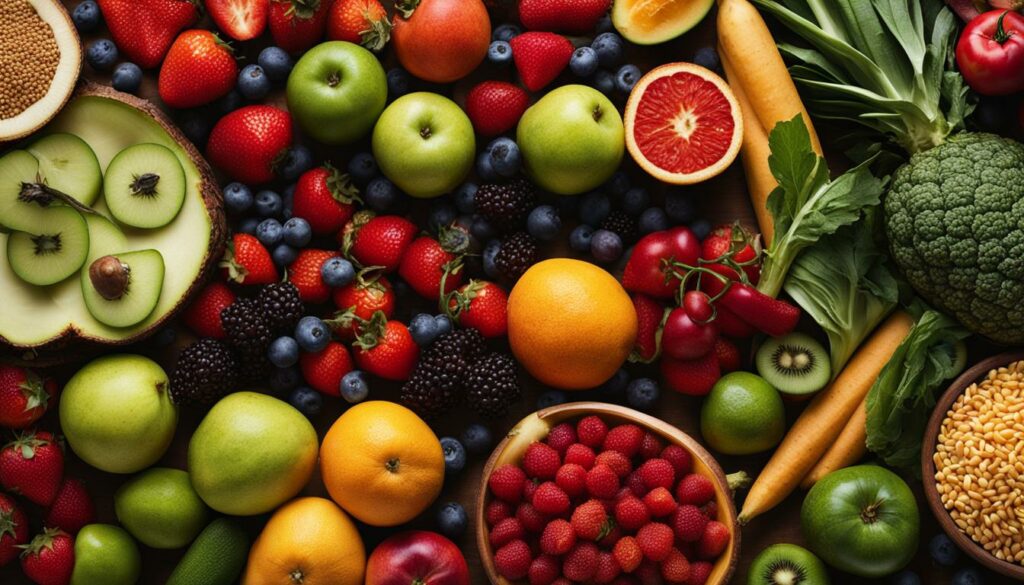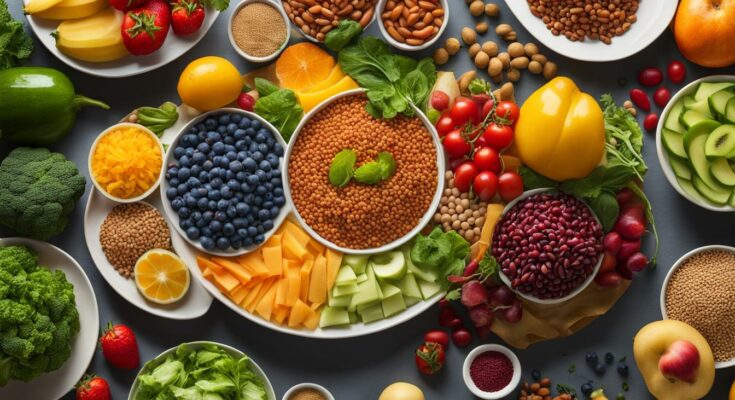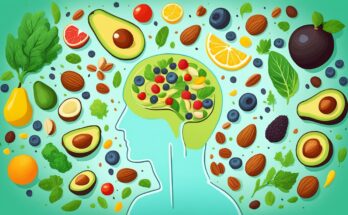Fiber is an essential nutrient that offers a wide range of health benefits. It helps regulate digestion, promotes heart health, aids in weight management, and supports diabetes management. Fiber is a type of carbohydrate that the body cannot digest, so it remains intact as it passes through the digestive system.
The importance of dietary fiber cannot be overstated. It is essential to include fiber-rich foods like whole grains, fruits, vegetables, and legumes in your diet to ensure optimal health and well-being. In this comprehensive guide, we will explore the myriad benefits of fiber and how it can contribute to a healthy lifestyle.
Key Takeaways:
- Fiber offers a wide range of health benefits, including aiding in digestion, promoting heart health, supporting diabetes management, and aiding in weight loss.
- Including fiber-rich foods in your diet is crucial to ensure optimal health and well-being.
- Fiber is a type of carbohydrate that the body cannot digest.
- Whole grains, fruits, vegetables, and legumes are excellent sources of dietary fiber.
- Incorporating fiber into your diet can help regulate digestion, control appetite, and maintain a healthy weight.
The Role of Fiber in Digestion
Fiber is a type of carbohydrate that the body cannot digest. Instead, it passes through the digestive system largely intact, adding bulk to the stool and promoting healthy bowel movements.
But how does fiber actually work to support digestion?
Let’s take a closer look at the process. When we eat high-fiber foods, like fruits, vegetables, and whole grains, the fiber in these foods absorbs water as it moves through the digestive system. This allows the stool to become softer and easier to pass, reducing the risk of constipation.
Additionally, fiber can help feed the beneficial bacteria living in our gut. These bacteria play a crucial role in maintaining a healthy gut microbiome, which can help support overall health.
So, what are some examples of high-fiber foods?
| Food | Amount of Fiber (grams) |
|---|---|
| Raspberries (1 cup) | 8 |
| Avocado (1 medium) | 10 |
| Lentils (1 cup, cooked) | 15 |
| Brussels sprouts (1 cup, cooked) | 6 |
Adding these high-fiber foods to your diet can help promote healthy digestion and overall wellness.
Fiber and Weight Loss
If you’re looking for a healthy and natural way to aid in weight loss, fiber is your new best friend. Fiber can help you feel fuller for longer periods, control your appetite, and reduce overall calorie intake.
But how exactly does fiber contribute to weight loss? When you consume high-fiber foods, such as whole grains, fruits, and vegetables, they add bulk to your meals without adding extra calories. This added volume can help fill you up and reduce hunger pangs, making it easier to stick to a calorie-controlled diet.
Research has shown that increasing your fiber intake by just 14 grams per day can lead to a 10% decrease in calorie intake and a weight loss of up to 4.5 pounds over 4 months.
But it’s not just the quantity of fiber that matters; the type of fiber you consume is also important. Soluble fiber, found in oats, beans, and certain fruits, has been found to be particularly effective in promoting weight loss and reducing belly fat.
| Food | Fiber Content (g) |
|---|---|
| 1 medium avocado | 9 |
| 1 cup raspberries | 8 |
| 1 cup cooked lentils | 15.6 |
| 1 cup cooked quinoa | 5.2 |
| 1 medium sweet potato | 5 |
Incorporating high-fiber foods like these into your diet can not only help you shed those extra pounds but also provide a range of other health benefits.

“Weight loss is not the only benefit of a high-fiber diet, but it is certainly a welcome one. By adding more fiber to your diet, you can also improve your digestion, reduce the risk of heart disease and diabetes, and increase overall feelings of well-being.”
The Link Between Fiber and Heart Health
Fiber plays a crucial role in maintaining heart health. Research suggests that a high-fiber diet can lower the risk of heart disease. Soluble fiber is particularly beneficial for heart health as it helps reduce LDL cholesterol levels, which can contribute to heart problems.
“Fiber intake is inversely associated with coronary heart disease incidence.”
A study published in the Journal of the American College of Cardiology found that increasing fiber intake was associated with a reduced risk of coronary heart disease. The study also found that incorporating high-fiber foods into the diet, such as oats, beans, and nuts, can promote a healthy heart.
| Type of Fiber | Benefits | Food Sources |
|---|---|---|
| Soluble Fiber | Reduces LDL cholesterol levels, promotes heart health | Oats, beans, nuts, apples, berries |
| Insoluble Fiber | Provides bulk for stool, supports healthy digestion | Whole wheat, bran, nuts, beans, vegetables |
As shown in the table above, both soluble and insoluble fiber play important roles in maintaining overall health. By incorporating high-fiber foods into your diet, you can support heart health and reduce the risk of heart disease.
Make sure to include fiber-rich foods in your meals to reap the many benefits they have to offer. Your heart will thank you!
Fiber and Diabetes Management
If you have diabetes, you may know that managing blood sugar levels is crucial to maintaining your health. But did you know that fiber can help with diabetes management?
Fiber is a type of carbohydrate that the body cannot digest. This means it does not raise blood sugar levels the way other carbohydrates do. Including high fiber foods in your diet can slow down the absorption of glucose into the bloodstream, helping to regulate blood sugar levels.
In fact, studies have shown that a high-fiber diet can improve blood sugar control in people with type 2 diabetes. Fiber can also improve insulin sensitivity, which is vital for diabetes management.
When it comes to high fiber foods, there are many options to choose from. Legumes such as lentils and black beans, whole grains such as brown rice and quinoa, and vegetables such as broccoli and Brussels sprouts are all excellent sources of fiber.
It is recommended that adults consume between 25 to 30 grams of fiber per day for optimal health. However, if you are not used to eating a high-fiber diet, it is essential to increase your intake gradually to prevent digestive discomfort.
By incorporating high-fiber foods into your diet, you can support diabetes management and enjoy the many health benefits that fiber has to offer.
Conclusion
Fiber is a crucial nutrient that provides numerous health benefits. From improving digestion and aiding in weight loss to promoting heart health and supporting diabetes management, incorporating high-fiber foods in your diet can contribute to overall well-being.
By choosing foods like fruits, vegetables, whole grains, and legumes, you can easily increase your fiber intake and reap the benefits. Experts recommend consuming around 25-30 grams of fiber per day, so make sure to check nutrition labels and plan your meals accordingly.
Overall, the health benefits of fiber are undeniable. By incorporating fiber-rich foods into your diet, you can support your body and enjoy a healthier, happier life!
FAQ
What does fiber help with?
Fiber helps with improving digestion, promoting heart health, aiding in weight loss, and supporting diabetes management.
What are the benefits of fiber?
The benefits of fiber include regulating bowel movements, preventing constipation, supporting a healthy gut, controlling appetite, reducing calorie intake, lowering LDL cholesterol levels, managing diabetes, and promoting overall well-being.
What is the importance of dietary fiber?
Including dietary fiber in your daily diet is important for maintaining optimal health. It provides essential nutrients, supports digestion, aids in weight management, improves heart health, and helps manage diabetes.




